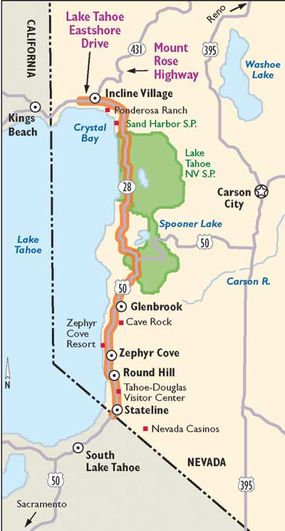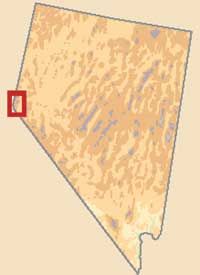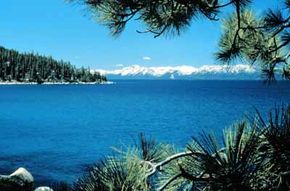The 28-mile Lake Tahoe-Eastshore drive is often called the most beautiful drive in America because of its breathtaking views of spectacularly clear Lake Tahoe. The pristine alpine lake is surrounded by the snowcapped mountains of the Sierras.
The byway is mostly undeveloped, except for the excellent recreational opportunities afforded by the lake, including the Zephyr Cove Resort, stables, campgrounds, the Tahoe Rim Trail, ski resorts, hotels, casinos, and fabulous golf courses.
Advertisement
As part of the Pony Express Trail and home to the historic sacred grounds of the Washoe Indians, Lake Tahoe's eastern shore offers a wide variety of activities during every season. The Lake Tahoe-Eastshore Drive is one of the most beautiful winter byways in the country, with the draw of an alpine climate and the ever-crystalline lake. Throughout the year, visitors come from miles around to enjoy Lake Tahoe.
Cultural Qualities of Lake Tahoe-Eastshore Drive
Lake Tahoe is well known for its diverse and interesting culture of both recreation and arts. Events take place through the year that attract visitors for reasons ranging from high drama to downhill ski relays.
During the summer months, artists gather at Lake Tahoe for exhibitions and workshops, making the area one of the best places to find cutting-edge and classic artwork. While Tahoe's art is a sight to behold, don't miss out on any of the many festivals that take place throughout the year. The festivals themselves are works of art.
Perhaps Lake Tahoe's best-known summer festival is the Lake Tahoe Shakespeare Festival at Sand Harbor, which takes place every summer. Imagine relaxing on a beautiful sand beach while enjoying your favorite Shakespearean drama. Enjoy the first-class performance near crystal blue waters, set against the stately backdrop of the Sierra Nevada, under a thousand glittering stars. The Lake Tahoe Shakespeare Festival's theater was recently rebuilt and is magnificent. Bring a jacket, a blanket, and some edibles, and then sit back, relax, and enjoy high drama in one of the most stunning locations imaginable.
Lake Tahoe offers a variety of winter festivals as well. Winter begins early here with the Native American Festival and Snow Dance. During the Snow Dance, a two-day event held the first weekend in October, Native Americans dance in full regalia and pray for snow to ensure an abundantly snowy winter. Lake Tahoe also heralds the arrival of winter with other festivals such as the Northern Lights Winter Festival and Snow Fest.
Historical Qualities of Lake Tahoe-Eastshore Drive
Lake Tahoe was originally a peaceful, earthy place, connected to the rest of the world by narrow trails over high mountain passes. Native Americans would gather in the summer to fish, hunt, and harvest nuts and berries for the long winter spent in Nevada's high desert.
The American Indians called their special place Da ow aga, meaning "the edge of the lake." It is believed that Tahoe got its name from the European settlers' mispronunciation of the first two syllables. Tahoe remains a gathering place for people hoping to enjoy the outdoors.
While on an expedition in search of the mythical Buenaventura River in 1844, explorers Kit Carson and John C. Fremont instead stumbled on Lake Tahoe, letting out the secret that had long been kept from the outside world. Fremont's accurate accounts of his High Sierra travels led other curious explorers to the mountain lake.
Soon after, gold and silver prospectors flocked to Lake Tahoe, but their explorations were in vain. However, in 1859, rich silver deposits in nearby Virginia City began a logging boom. While the Comstock Lode opened the area to big business, it nearly stripped the Lake Basin of its first growth of trees because its lumber was used for timber supports in the underground mines.
As more people laid eyes on the natural treasure, word of the wondrous lake spread through the land. Among these proclaimers was humorist Mark Twain, who described the area as wholesome and pure. Stagecoach stops over the Sierra exposed visitors to Tahoe's scenic beauty and tranquility. Many were lured to stay because they felt that they had found paradise.
Westerners began to develop Lake Tahoe's shore in the early 1900s as a summer retreat for San Francisco's elite. Plush hotels sprang up, and guests amused themselves at Lucky Baldwin's Tallac House and Casino, known today as the Tallac Historic Site at South Shore. Gambling was illegal on the California side of the lake, but enforcement was sporadic, and arrangements with cooperative authorities were routine. Raiding law enforcers often found patrons playing nothing more objectionable than pinochle and canasta.
By 1941, the Tahoe Tattler was reporting that Tahoe's number two industry was nightlife, a close second to the resorts. Each weekend, an estimated 3,000 people would flock to the bars, casinos, and dance halls and spend anywhere from 25 cents for a glass of beer to $50,000 for an expensive game of chance.
A boom of another kind was soon occurring at Lake Tahoe. Using Nevada's advantageous tax laws as bait, an enterprising businessman named Norman Blitz convinced more than 80 of the nation's most rich and famous to make Lake Tahoe their home. This effort sparked the development of thriving real estate and construction industries at the lake.

Qualities of Lake Tahoe-Eastshore Drive
Lake Tahoe is a masterpiece of nature. Surrounded by mountains, Lake Tahoe is the highest lake in the United States, the third deepest lake in North America, and the tenth deepest lake in the world. The lake holds more than 39 trillion gallons of water.
Lake Tahoe is incredibly blue because the thin, clear mountain air allows the lake's pure, crystal-clear water to reflect the blue sky above. For this reason, the lake also appears a dramatic red during sunsets and reflects a somber, churning gray during storms. The spectacular shoreline is 71 miles long, 29 miles of which are on the Nevada side. Beautiful vegetation and numerous kinds of wildlife inhabit the area in and around Lake Tahoe.
Lake Tahoe was created millions of years ago through the shifting of geological faults. Immense forces began the process with the tilting of the Sierra Nevada block. As a result, two parallel faults were developed: One margin created the Carson Range and the other the Sierra Nevada.
About two million years ago, volcanic activity reshaped the entire landscape of the region. Lava formed a barrier across the basin's northeastern outlet, creating a natural dam and, eventually, Lake Tahoe. Next, vast glaciers developed in the surrounding mountains. These gradually moved down the V-shape canyons on the western side of the lake. The massive glaciers scoured away any loose rock, and the canyons were reshaped into the wide, U-shape valleys of Emerald Bay, Fallen Leaf Lake, and Cascade Lake.
Lake Tahoe has a variety of unique plant and animal life that makes hikes and walks an exciting experience. One particularly striking plant, a fairly common sight when the snow is melting, is the snow plant. This member of the wintergreen family is an asparaguslike plant that doesn't photosynthesize; it receives nourishment from the roots of neighboring plants and decaying organic matter. Despite its somewhat disturbing means of survival, the plant is extremely lovely, rare, and (fortunately) protected by law.
Another beautiful flower is the crimson columbine, a well-known flower that grows in moist areas and is appreciated for its delicate features. The lupine is also easily recognized by the palmate leaf, resembling the fingers of a hand, and striking blue flowers.
While the Lake Tahoe area is full of a variety of animal life, from coyotes to bears, you will likely see various kinds of birds most often. The western tanager is a beautiful bird and one of the most colorful in the Lake Tahoe Basin, with a red head and a bright yellow body and black markings on its back, wings, and tail.
Another bird in the area is the mountain chickadee, the most common bird in the Tahoe Basin. This bird is small with a black cap, a black bib, and a white line over each eye. It is acrobatic and swings from branches as it hunts for insects and seeds; it also makes a distinctive three-note whistle.
Qualities of Lake Tahoe-Eastshore Drive
When it comes to winter activities, Lake Tahoe has it covered (literally). Tahoe has more snow (averaging about 400 inches per season), more variety, and more ways to play than just about any other place. Lake Tahoe has the largest concentration of ski resorts in North America, including six world-class resorts you won't want to miss. The terrain ranges from leisurely bowls to steep hills that make your heart thump.
However, excellent skiing and snowboarding are not all that Lake Tahoe has to offer. Snowmobiling, snowshoe excursions, snow tubing, and cross-country treks open up the millions of acres of national forest land waiting to be explored. Ice skating, sleigh rides, and sledding are fun activities close to the byway. Lake Tahoe also hosts numerous special events all winter long, including Snow Fest.
If you prefer warmer weather, Lake Tahoe's links are second to none. Extra altitude makes even the worst golfer feel like a pro, and the breathtaking backdrops and outstanding course architecture will make bogeys seem a little less burdensome. The Lake Tahoe region boasts more than a dozen courses at all levels of play.
Surrounded by national forest lands, wilderness, and state parks, Lake Tahoe possesses some of the country's most spectacular scenery. With almost 300 miles of trails, hikers have plenty of room to roam. Backcountry buffs can trek up waterfall trails, hike along wildflower-carpeted meadows, or visit serene alpine lakes and stunning overlooks of Lake Tahoe. There are flat, moderate, and steep trails to suit every ability.
Looping its way around the lake, the Tahoe Rim Trail, a hiking and equestrian trail, offers 165 miles of trail, with elevations ranging from 6,300 feet to 9,400 feet. This trail is generally moderate in difficulty, with a 10 percent average grade, and provides views of Lake Tahoe, the high desert, and snowcapped peaks of the Sierra Nevada.
Trailheads accessible along the byway include Tahoe Meadows Trailhead to Tunnel Creek Road (Highway 431), Spooner Summit Trailhead (Highway 50), and Spooner Summit South to Kingsbury Grade. The Tunnel Creek Station Road Trail starts at Highway 28 across from Hidden Beach about one mile past Ponderosa Ranch (there's no sign, so look for the gate). This is a steep trail road, about 1-1/2 miles each way, located at the ruins of the western portal of the old log flume tunnel. There is limited parking along Highway 28. The Marlette Lake Trail starts near the Spooner Lake Picnic Area at the junction of Highway 28 and 50 at the green metal gate on the east side of Highway 28. This trail is about five miles each way to the lake and passes through mostly mild terrain.
A combination of one of the world's top single-track trails, spectacular views, and miles of open backcountry beckons bikers from around the world to the Lake Tahoe basin. The best-known Tahoe bike trail is the spectacular Flume Trail, carved out of the edge of a mountain some 2,000 feet above the lake's stunning east shore. The Flume Trail follows a precarious route dug out of the granite cliffs more than a century ago by laborers developing a water supply and lumber transport for the mines of the Comstock Lode.
Today, the 14-mile Flume Trail offers a challenging ride with a 1,000-foot elevation gain and sweeping views, all within Nevada's Lake Tahoe State Park. The common starting point for this trail is Spooner Lake, which features parking and trail information. Located at the junction of Highways 28 and 50, Spooner Lake is a 15-minute drive south from Incline Village. Groves of aspen trees, towering peaks, old-growth pine, and high mountain lakes greet bikers along the Flume Trail.
After a quick turn onto a small outlet creek, the trail suddenly clings to a slope overlooking the azure Lake Tahoe. The northern terminus of the trail can take the rider to either Sand Harbor or the Ponderosa Ranch. For the ambitious rider, a
loop via Tunnel Creek Road, Red House, and Hobart Lake creates a 25-mile loop back to Marlette Lake, as well as a stunning downhill ride to Spooner.
Find more useful information related to Nevada's Lake Tahoe-Eastshore Drive:
- Nevada Scenic Drives: Lake Tahoe-Eastshore Drive is just one of the scenic byways in Nevada. Check out the others.
- Incline Village, Stateline : Find out what there is to do in these cities along Lake Tahoe-Eastshore Drive.
- Scenic Drives: Are you interested in scenic drives beyond Nevada? Here are more than 100 scenic drives throughout the United States.
- How to Drive Economically: Fuel economy is a major concern when you're on a driving trip. Learn how to get better gas mileage.
Advertisement

